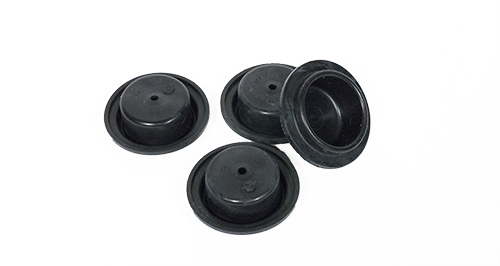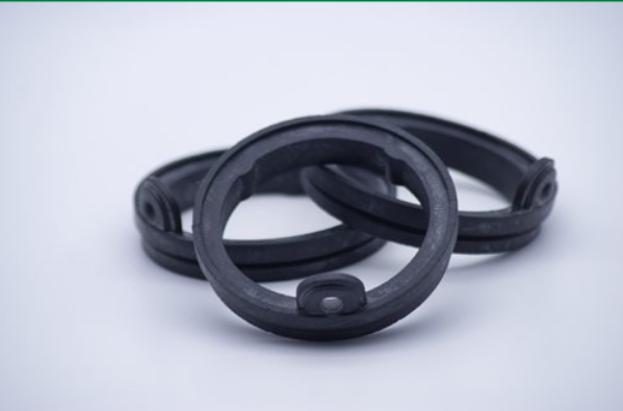Rubber diaphragms are flexible rubber membranes, sometimes reinforced with fabric, strategically placed to prevent unwanted transfer of substances between two places by creating a seal. They can be used to separate two gasses, two liquids, or one gas and one liquid that should not mix.
It is a bit of an industry misconception that all rubber diaphragms are thin pieces of rubber. In fact, diaphragms come in a wide variety of shapes and sizes. The thickness depends on how big in diameter the diaphragm is and how flexible you need it to be. At Custom Rubber Corp., we’ve manufacturered 28-inch diaphragms that were ⅛” thick and one-inch diaphragms only millimeters thick.
Diaphragms can be made of a wide variety of rubber materials, depending on final application. Read on to learn more about the benefits of rubber diaphragms and when you should use one in place of a gasket or traditional seal.
HOW AND WHERE ARE RUBBER DIAPHRAGMS BEST USED?
Rubber diaphragms have a wide range of applications, but are most often used in environments where pressure differentials are present. With low fluid permeability and the ability to flex from side to side, rubber diaphragms act as a sealing solution while providing a consistent pressure differential.
Elastomers, and rubber in particular, are a great material to use for diaphragms due to their elastic properties. Rubber diaphragms allow for a wide range of pressure differentials while remaining durable and flexible.

The versatility in size, thickness and flexibility means diaphragms can be found in everything from pumps to regulators, meters, accumulator tanks and beyond. Customized rubber diaphragms are often found in specialized devices.
At Custom Rubber Corp., for example, we’ve made large rubber diaphragms that act as a shock absorber in hydraulic accumulator tanks on oil drilling rigs. We’ve also made smaller diaphragms for accumulator tanks on properties that use well water.
On a smaller scale, our team also manufactured a customized diaphragm that acted as a pressure relief valve for a company that made valves for natural gas systems. While most diaphragms are round, the diaphragm we molded was actually a square shape.
HOW ARE RUBBER DIAPHRAGMS MADE?
Rubber diaphragms are commonly made with rubber materials like
○EPDM
○Nitrile (NBR)
○Silicone
○Neoprene®
○Natual Rubber
Diaphragms made only of rubber are called homogeneous rubber diaphragms. In this case, the diaphragms are typically compression molded because they’re so thin. It’s difficult to make a thin, flexible membrane through injection molding or transfer molding.
Some rubber diaphragms, however, are reinforced with fabric to enhance durability. In this case, fabric like cotton or kevlar will be sandwiched between two layers of rubber during production.

This process requires very high attention to detail by the machine operator as it’s easy for the fabric to slide around and end up out of place. Sometimes pre-molding the fabric helps prevent movement or creases, but beware: an under qualified machine operator may end up wasting quite a bit of rubber when producing their first fabric-reinforced diaphragms.
WHAT IS THE DUROMETER OF RUBBER DIAPHRAGMS?
The durometer of rubber diaphragms is variable, but stays in the center of the Shore A scale. Diaphragms need to move around, so they need to be fairly thin and flexible, but they can’t rupture the second a pressure differential hits. The exact durometer depends on the final part design and depends on size and thickness.
For example, it would be ill-advised to make a 90 durometer diaphragm. It would make more sense to make a 60 durometer rubber diaphragm that’s a bit thicker. Durometer is directly correlated to stretch, so you can play with the product’s design to keep it around that sweet spot in the center of the Shore A scale.
Interested in learning all about durometer? Click here to read all about the basics of durometer.
RUBBER DIAPHRAGMS VS. GASKETS VS. SEALS
Rubber diaphragms can be considered a type of seal as they usually end up anchored between two places and have sealing features around the edges to prevent transmission of materials. It’s usually not cost effective or practical to secure a diaphragm in place and then add an extra seal as you could disrupt pressure differentials.
As we established in previous articles, a gasket is just a type of seal, with the two terms often being used interchangeably. A rubber diaphragm is a more dynamic type of seal specifically designed to flex back and forth. Both gaskets and diaphragms fall under the broader category of rubber seals.

